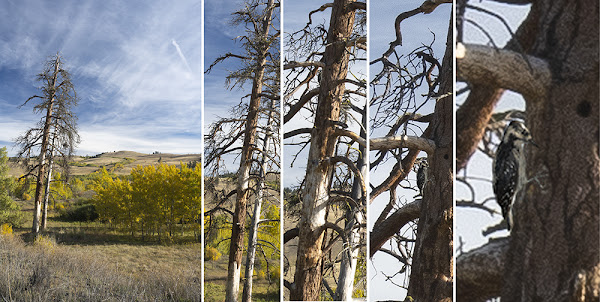Finding hidden treasures and resolution.

The image to the left was originally captured on a full-frame mirrorless camera sporting a 50 megapixel sensor. The original image was approximately 5500x8300 pixels in size. The downside of such large photos is the amount of memory a single image takes up; the raw file is about 72 megabytes. It doesn't take many of these to fill up a memory card or even some of the smaller hard drives.
The advantage of the massive pixel depth comes in resolution. A full-sized image allows significant cropping. The progression of images to the right shows a gradual enlargement part of the scene. Examine the third image; you will just see a hint of the woodpecker near the top of the frame. You can see it relatively clearly in the fourth panel. The image farthest to the right clearly shows a male harry woodpecker (you can just make out the red crown).
Most of the images I have captured over the last half-dozen years have been with 20 and 24 megapixel cameras. I have found the pixel depth sufficient in my work; the truth is 50 megapixels is really more than I need. I could set the pixel depth to something smaller, but the truth is that I would rather have too many pixels when cropping rather than not enough.
Fortunately, I use high-capacity memory cards and have two five TB (terra byte) drives on my computer so that I will not likely run out of storage space any time soon. I cannot fathom using a camera that produces images larger than 50 megapixels. They exist, but the cost is currently prohibitive and file sizes that large are well beyond my needs.
Thanks for reading. www.ericspix.com
Side note: The original image did not have the woodpecker in it. I added it by copying and pasting a photo I took at an earlier time. A little trimming in Photoshop and resizing to fit the situation was all I needed to make it all work.



Comments
Post a Comment